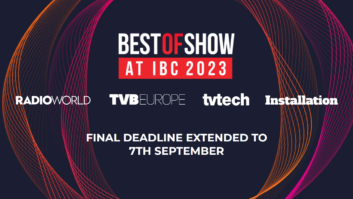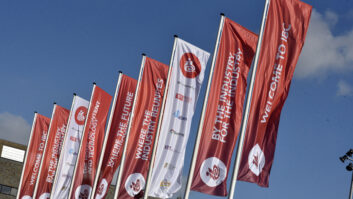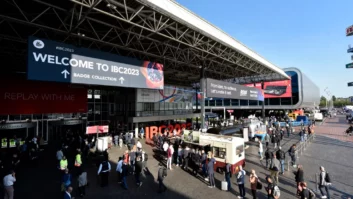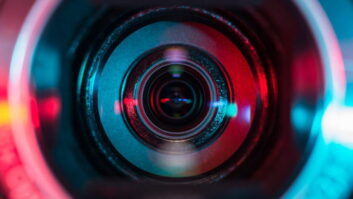This year’s IBC, which took place at the Amsterdam RAI, as usual, from September 15-18 remains very much a broadcast technology expo. However, just as ISE is absorbing an increasing number of broadcast technology vendors into its exhibition ranks (with ISE managing director Mike Blackman not shy in vocalising his goal to grow this side of the show), IBC is seeing an influx of what some might see as traditional AV manufacturers – and presumably integrators too. The reason? The ongoing convergence between ‘traditional’ broadcast and AV technologies – much reported on within these pages, and set to be increasingly bigger news as we move towards next year’s ISE.
MAIN FOCUS
Many of IBC 2023’s ‘more traditional’ AV vendors and visitors were likely at the RAI to exhibit and experience the fast-moving world of virtual production technologies and solutions, which were also front and centre at ISE earlier this year. Sony, in particular, was pushing VP hard on its booth, which had its own dedicated hall (13)! Sony’s theme was Creativity Connected, which reflects the company’s “long-term” commitment to providing “core technologies” for its customers, to allow them to be more “creative and efficient” – but with an “environmentally responsible” strategy baked in.
Sony’s complete ecosystem of solutions, products and services reflect four strategic areas of focus which, it says, are shaping the media industry:
Networked Live, an evolving platform enabling the optimisation of people, locations, and processing for live production environments; Creators’ Cloud platform, for media production, sharing and distribution; Imaging, with “colour science, flexibility and ease of operation” within Sony’s cameras and lenses; and of course VP, combining the Virtual Production Toolset software, Crystal LED displays and the VENICE camera series.
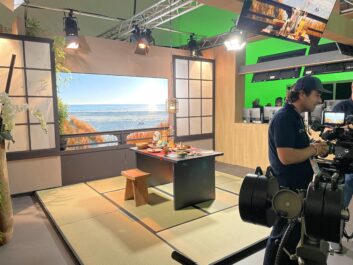 Sony is promoting its virtual production solutions as a the ‘easy win’ for TV production and corporate production suites, with colour consistency across the company’s cameras and displays, and a partnership with Unreal Engine which allows productions to be pre-planned virtually with a virtual VENICE cam to save on production studio booking costs.
Sony is promoting its virtual production solutions as a the ‘easy win’ for TV production and corporate production suites, with colour consistency across the company’s cameras and displays, and a partnership with Unreal Engine which allows productions to be pre-planned virtually with a virtual VENICE cam to save on production studio booking costs.
It’s, of course, of no surprise that virtual production is at the forefront of AV’s convergence into broadcast (and vice versa), as corporate enterprises look to add VP suites to their tech arsenals. In addition, the common use of IT-based infrastructures running IP audio and video systems has been driving the overlaps, with the cloud adding an extra dimension for both sectors.
HARD PUSH
Another company pushing VP at IBC – as it did very successfully at ISE 2023 – was Absen. The company partnered with a range of leading broadcast industry brands on its booth, including Brompton Technology for its LED video processing (SX40, XD, S8); ARRI, for motion picture equipment (AMIRA Live, 24mm Prime Lens, AMIRA Live PL Hirose Mount); stYpe’s camera tracking technology (RedSpy 3.0 Camera Tracking Package, stypeKit AutoAim); Big Purple Productions, for production management and esports solutions; Smart Stage’s xR solutions (immersive mixed reality studio replacing traditional green screen); and disguise, for its media servers (vx 2, rx II).
On the Sennheiser stand, the company partnered with Sennheiser Group companies Neumann, Dear Reality and Merging Technologies to demonstrate immersive production workflows as well as solutions for audio capture, monitoring and processing.
NEW ADDITION
Riedel Communications unveiled its MediorNet HorizoN, a new addition to the MediorNet family of video networking and processing devices. This hybrid processing platform is said to blur the boundary between SDI-based and SMPTE ST 2110 infrastructures with a “dense array” of UHD gateways. Utilising a software-based app concept, HorizoN is expected to be a boon to video ecosystems in the broadcast, entertainment, sports, corporate, and government sectors.
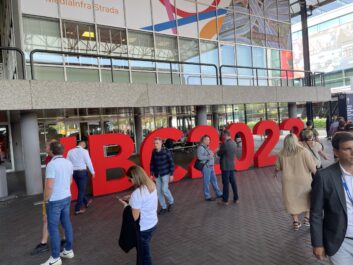 Ross promised an immersive experience focusing on extended reality (XR), integrating AI, robotic camera systems, enhanced cloud production, and hyperconverged infrastructure, in its pre-show promotional material, and whilst Installation wasn’t necessarily immersed as such, the company’s huge booth certainly covered all areas. Ross is perhaps seen in IBC circles as a broadcast manufacturer, but the company still considers itself AV at its core, so this was more of an AV-into-broadcast situation than the other way around! That said, Ross is perhaps the perfect example of a company successfully straddling both sectors, and one where it is increasingly impossible to see the joins.
Ross promised an immersive experience focusing on extended reality (XR), integrating AI, robotic camera systems, enhanced cloud production, and hyperconverged infrastructure, in its pre-show promotional material, and whilst Installation wasn’t necessarily immersed as such, the company’s huge booth certainly covered all areas. Ross is perhaps seen in IBC circles as a broadcast manufacturer, but the company still considers itself AV at its core, so this was more of an AV-into-broadcast situation than the other way around! That said, Ross is perhaps the perfect example of a company successfully straddling both sectors, and one where it is increasingly impossible to see the joins.
Audinate was keen to reiterate the news that it had shipped more than one million hardware and software units of its Dante AV-over-IP solution – big news for both broadcast and AV of course – the greatest number of Dante units ever shipped in a 12-month period. The company also announced that Dante Connect, the audio transport solution for cloud-based workflows, is now shipping. Designed to meet the needs of Tier-1 broadcasters, Dante Connect enables mixing editors and A1s to support remote audio production workflows.
AWARD WINNER
Vizrt was promoting its impressive Best of Show winning (see page 45 for all the Installation winners) TriCaster Mini Go on its booth. Boasting the company’s simplest set-up yet, and with a host of professional-level video production features that are intended to meet the needs of up-and-coming creators, TriCaster Mini Go is a scalable solution with USB and NDI connectivity. Very much the entry level video production solution, the Mini Go is perhaps ideal for SMEs looking to add production to its wheelhouse.
Clear-Com showcased the latest advances in its IP-based intercom for a wide variety of applications. It highlighted the features of its flagship Eclipse HX Digital Matrix Intercom System, including Dynam-EC real-time production software, role-based workflows, and the new 2X10 Touch desktop touchscreen panel. The IP-based Arcadia Central Station was also demonstrated, including the HXII-DPL Powerline device, an IP interface that delivers power and digital audio from Arcadia to HelixNet Digital Network systems.
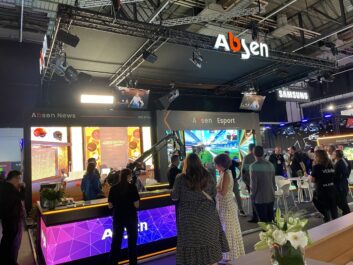 As part of its IBC presentations, Samsung worked with virtual staging specialists White Light (part of d&b solutions and developer of SmartStage), demonstrating how IVC can be used in conjunction with specially made visual material. Samsung also exhibited its latest touch-LED interactive displays, in collaboration with U-touch, and signage products.
As part of its IBC presentations, Samsung worked with virtual staging specialists White Light (part of d&b solutions and developer of SmartStage), demonstrating how IVC can be used in conjunction with specially made visual material. Samsung also exhibited its latest touch-LED interactive displays, in collaboration with U-touch, and signage products.
Samsung similarly straddles both AV and broadcast, and claimed its stake in the virtual sector earlier this year with the launch of The Wall for virtual production. Based on its IVC series units, this set-up enables the creation of large-scale LED walls to produce content. The displays are integrated with real-time visual effects, which is said to reduce the time and cost of producing material, and also feature Black Seal Technology for purer black levels to deliver lifelike levels of texture, volume and a wide range of shades.
EXTRA EMITTERS
Brompton Technology, which has established itself in both AV and broadcast over the last 11 years, introduced its new TrueLight LED processing system, which is aimed at panels with extra emitters, including RGBW, and situations where these are used as the lighting source. This includes virtual production volumes or theatre productions and fixed installations. TrueLight is based on Brompton’s Dynamic Calibration technology, which enables RGBW panels to be colour calibrated for each pixel and also gives the choice of what spectrum to use for the right look.
Brompton also partnered with LED display manufacturer Absen at IBC, as part of its immersive technologies demonstrations – as mentioned above – utilising filmmaking equipment from ARRI, stYpe’s camera tracking technology, Big Purple Productions’ management and esports systems, WhiteLight’s SmartStage XR platform (which was showcased on the d&b solutions stand) and disguise’s media servers and live visuals.
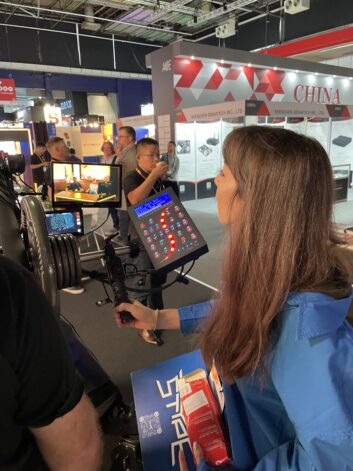 Another LED lighting developer, INFiLED, sees the new Brompton TrueLight and its own Infinite Colors technology as providing what it calls a “new path for AV productions”, combining colour control and virtual production processing. Infinite Colors adds a fourth emitter to the standard RGB (red, green, blue) format, which is said to increase the colour spectrum that can be seen by professional cameras. The technology is designed to produce a higher CRI (colour rendering index), resulting in more accurate reproduction of colours and textures. The first of INFiLED’s range to feature Infinite Colors is the Studio AR Series was also shown during IBC.
Another LED lighting developer, INFiLED, sees the new Brompton TrueLight and its own Infinite Colors technology as providing what it calls a “new path for AV productions”, combining colour control and virtual production processing. Infinite Colors adds a fourth emitter to the standard RGB (red, green, blue) format, which is said to increase the colour spectrum that can be seen by professional cameras. The technology is designed to produce a higher CRI (colour rendering index), resulting in more accurate reproduction of colours and textures. The first of INFiLED’s range to feature Infinite Colors is the Studio AR Series was also shown during IBC.
UNDOUBTED SUCCESS
This year’s IBC was undoubtedly a success. IBC 2022 attracted 37,071 visitors from 170 countries, which was 32 percent down on the attendance for the last in-person IBC in 2019 – presumably a hangover from Covid. There were 1000 exhibitors. This year’s event recovered somewhat, with over 1,250 exhibitors and a 16% increase on 2022’s attendees to 43,065 attendees.
It will be interesting to see if numbers continue to rise – both for exhibitors and visitors – as ISE continues its push to lure the more broadcast-facing vendors to the Barcelona Fira, or whether IBC will start to feel the pinch. Certainly, as the lines between AV and broadcast continue to blur, it’s hard to see how both shows will keep growing in the years to come.
Click here to check out this year’s Best of Show at IBC Installation award winners.
